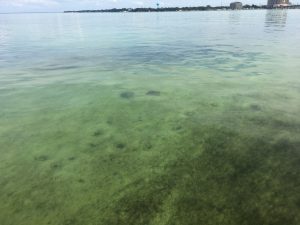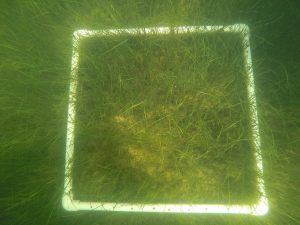Seagrasses are flowering, subaquatic plants found at shallow depths in protected bays, estuaries, and the Gulf of Mexico. Seagrasses are imperative to the health of our bay.
Seagrass:
Choctawhatchee Bay has two main types of seagrass. Shoal Grass, or Halodule wrightii, is the most commonly found species in the bay and thrives in areas with higher salinity levels. The species sports long, narrow strands and can form carpet-like beds. Widgeon grass, or Ruppia maritima, is often said not to be a “true” seagrass because it tolerates both freshwater and marine water. It has thin leaves that grow from branched stems and has buds or blooms.
In 2009, CBA began a long-term monitoring project to assess the coverage and abundance of seagrass in the Choctawhatchee Bay. In a 2016 collaboration with the Florida Fish and Wildlife Research Institute (FWRI), we conducted in-depth monitoring protocols involving light attenuation, seagrass growth, abundance, stingray transects, and related water quality variables. Since 2016, the FWRI Reports of the Seagrass Integrated Mapping and Monitoring (SIMM) Program included our data. The SIMMs program is available at: http://myfwc.com/research/habitat/seagrasses/projects/active/simm/simm-reports/.
The most recent report is available here.
CBA has 40 seagrass monitoring locations around the Choctawhatchee Bay and works to monitor 20 sites each year.
Today, our bay’s seagrasses require our protection. You can help protect our seagrass meadows by educating yourself and others around you on seagrass safe practices - this applies to boaters in particular. Use navigational channels to avoid seagrass beds. Slow your speed and trim up your motor if near a seagrass bed. Idle to a safe depth before returning up onto a plane. Lastly, if aground, turn off and trim up your motor, and push your vessel off of the bed to decrease the impact.
Learn more at Be Seagrass Safe | Learn how to keep seagrass beds healthy





